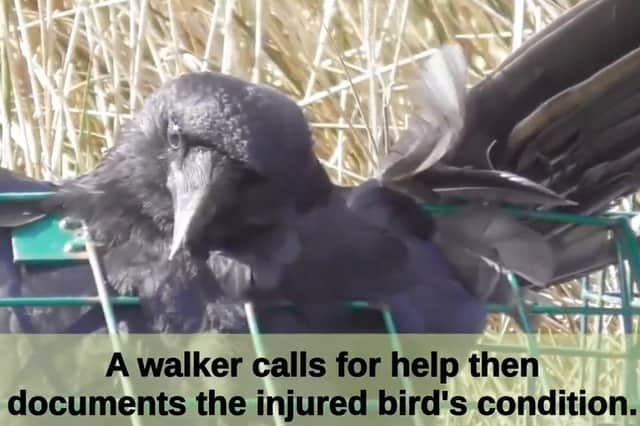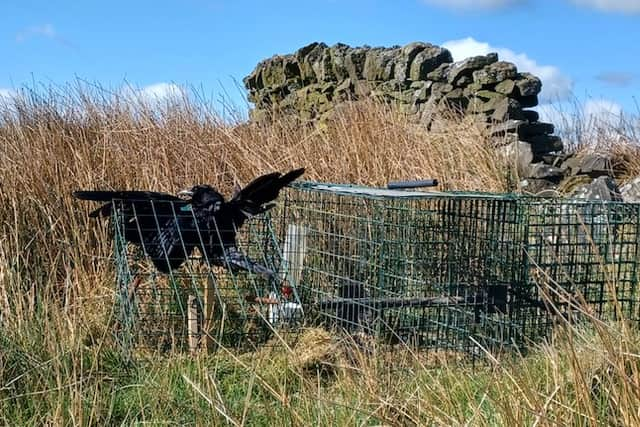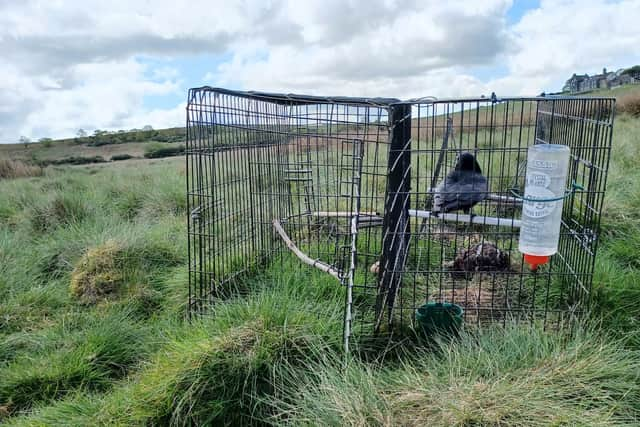'Inherently cruel' - Duke of Rutland criticised over bird traps on moorland near Sheffield
and live on Freeview channel 276
The Duke of Rutland has been criticised over a ‘cruel’ bird trap on his moors near Sheffield.
A video shows a live crow in the jaws of a trap, with a second in an adjacent cage, yards from the Long Causeway near Stanage Pole, a popular path between Redmires and Stanage Edge. They were discovered by walkers who called the RSPCA.
Advertisement
Hide AdAdvertisement
Hide Ad

The duke of Rutland owns hundreds of acres between Stanage Edge and the A57 at Moscar. The moors are managed for grouse shooting.
An RSPCA spokesperson said the crow was in a clam trap set up next to a decoy bird in a larsen trap.
They added: “It was very sad to discover that a crow, who had been caught in a trap at Moscar Moor, was in such a poor condition. The bird was not injured as a result of falling into the trap, but was already emaciated and suffering from a parasitic infection. The kindest thing to do was to put the bird to sleep.
“Clam traps and larsen traps are legal, but as part of the licence issued for their use they do require to be checked regularly and we have reminded the owners of their responsibilities to do so.”
Advertisement
Hide AdAdvertisement
Hide AdThe video was posted online by Moorland Monitors, a group ‘working to protect persecuted wild species and wild spaces on driven grouse shooting estates’.
Spokesman Adam Davies said live-capture traps were “inherently cruel” and a longstanding problem on the duke’s land.


He added: “So many methods of ‘predator control’ including traps and snares rely on outdated devices and ideologies, which have no place in modern society. Gamekeepers have repeatedly shown total disregard for animal welfare and environmental protection legislation. The shooting industry cannot be trusted to protect our precious uplands, and official bodies such as the Peak Park must embrace a more environmentally-sound, nature-friendly future for our uplands.”
And he urged the duke to join the growing number of landowners who use their land "for social and environmental good."
Advertisement
Hide AdAdvertisement
Hide AdHe added: “Driven grouse shooting is now widely recognised as outdated and heavily associated with wildlife crime and environmental harm.”
The duke, based at Belvoir Castle in Leicestershire, did not respond to The Star but his spokesman confirmed receipt of emails.


Neighbouring landowners include Sheffield City Council, which owns moors to the south east of Long Causeway. It banned blood sports in 1982, while a ban on moorland burning has been in place ‘for at least 10 years’. Severn Trent Water owns land around the nearby Ladybower, Derwent and Howden reservoirs.
A spokesperson said: “We do not condone or permit the use of bird trapping across our land, and to the best of our knowledge this does not happen.”
Advertisement
Hide AdAdvertisement
Hide AdUnited Utilities, which owns land in the North West, has led the way among water companies. Last month it announced it will not renew any of its 20 shooting licences, effectively banning the practice. The last one is set to expire ‘by 2027’.
A spokesman for the Peak District National Park Authority said shooting for sport on its land was banned in the early 1980s.
He added: “The authority undertakes limited, seasonal use of legal Larsen traps on some of our landholdings as part of targeted and prescribed approaches to wading bird conservation only. We do not use ‘multi-catch’ traps. This work is always undertaken in full accordance with all relevant legislation and codes of practice, including relevant daily welfare checks.”
In March, the National Trust said it would not renew a shooting licence covering a huge swathe of moorland at Park Hall off the Snake Pass near Sheffield due to ‘concerns over management techniques’.
Advertisement
Hide AdAdvertisement
Hide AdThe aim was to restore it ‘for the benefit of nature, climate and people,’ a spokesperson said.


It came after two rare male Hen Harriers disappeared from a shooting moor in the Peak District last May, leading to the loss of two nests and 10 eggs.
In March this year a hen harrier disappeared from moors at Upper Midhope near Sheffield. Its tag showed unusual activity, followed by signals suggesting it was dead. The bird has never been found.
Police confirmed the recovered tag had been cut from the bird but a criminal investigation had failed to identify those responsible.
In April, the Peak District National Park Authority closed a bird of prey initiative after 12 years after population numbers failed to improve.
Comment Guidelines
National World encourages reader discussion on our stories. User feedback, insights and back-and-forth exchanges add a rich layer of context to reporting. Please review our Community Guidelines before commenting.